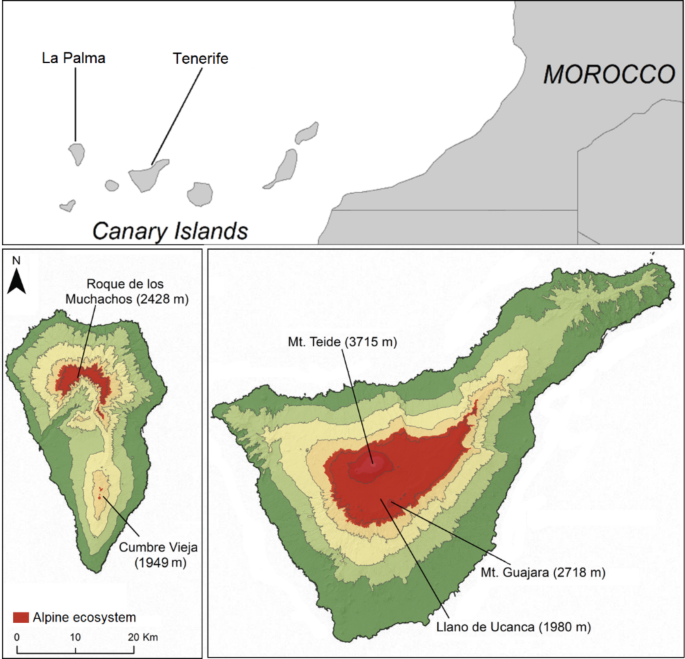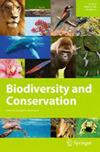Assessing global warming vulnerability of restricted and common plant species in alpine habitats on two Oceanic Islands
IF 3
2区 环境科学与生态学
Q1 BIODIVERSITY CONSERVATION
引用次数: 0
Abstract
Abstract Climate change is modifying plant communities and ecosystems around the world. Alpine ecosystems are of special concern on oceanic islands, due to their characteristic higher endemicity percentage, small area and undergoing severe climate change impact in the last few decades. During recent decades there has been increasing interest in the effects of climate change on biodiversity and a range of methods have been developed to assess species vulnerability. However, some new insights are necessary to obtain useful information for species management on oceanic islands. Here in the alpine area of two oceanic islands (Tenerife and La Palma) we evaluate the drivers that best explain the vulnerability of 63 endemic species along three scenarios, covering recent past to present and two future projections (2041–2060 and 2061–2080). The selected drivers were: loss of potential area, mismatch index between potential and occupied areas in different scenarios, and adaptive capacity constraints. We assess the influence of potential area size and whether the drivers of risk and the vulnerability for common, restricted and rare species are significantly different. Our results indicate that management must be widely distributed over the species, and not only focus on restricted species. Evidence for this was that drivers directly deriving from climate change showed no significant differences in their impact on the rarity groups identified. Vulnerability depends partially on the potential area size, showing a more complex picture where constraints on the adaptive capacity of the species have a strong enough influence to modify the effects of the characteristic drivers of climate change.

评估两个大洋洲岛屿高山栖息地限制和常见植物物种的全球变暖脆弱性
气候变化正在改变世界各地的植物群落和生态系统。高山生态系统在海洋岛屿上因其特有率高、面积小和近几十年来遭受严重气候变化影响的特点而受到特别关注。近几十年来,人们对气候变化对生物多样性的影响越来越感兴趣,并开发了一系列评估物种脆弱性的方法。然而,为了获得对海洋岛屿物种管理有用的信息,一些新的认识是必要的。在两个海洋岛屿(特内里费岛和拉帕尔马岛)的高山地区,我们根据三种情景评估了最能解释63种特有物种脆弱性的驱动因素,涵盖了最近的过去到现在以及两个未来预测(2041-2060和2061-2080)。选择的驱动因素有:潜在面积损失、不同情景下潜在与占用面积失配指数、适应性容量约束。我们评估了潜在面积大小的影响,以及常见、限制和稀有物种的风险驱动因素和脆弱性是否存在显著差异。我们的研究结果表明,管理必须广泛分布在物种上,而不仅仅是集中在限制物种上。这方面的证据是,直接来自气候变化的驱动因素对已确定的稀有物种群体的影响没有显著差异。脆弱性部分取决于潜在的面积大小,这显示了一种更复杂的情况,在这种情况下,对物种适应能力的限制具有足够强大的影响,可以改变气候变化特征驱动因素的影响。
本文章由计算机程序翻译,如有差异,请以英文原文为准。
求助全文
约1分钟内获得全文
求助全文
来源期刊

Biodiversity and Conservation
环境科学-环境科学
CiteScore
6.20
自引率
5.90%
发文量
153
审稿时长
9-18 weeks
期刊介绍:
Biodiversity and Conservation is an international journal that publishes articles on all aspects of biological diversity-its description, analysis and conservation, and its controlled rational use by humankind. The scope of Biodiversity and Conservation is wide and multidisciplinary, and embraces all life-forms.
The journal presents research papers, as well as editorials, comments and research notes on biodiversity and conservation, and contributions dealing with the practicalities of conservation management, economic, social and political issues. The journal provides a forum for examining conflicts between sustainable development and human dependence on biodiversity in agriculture, environmental management and biotechnology, and encourages contributions from developing countries to promote broad global perspectives on matters of biodiversity and conservation.
 求助内容:
求助内容: 应助结果提醒方式:
应助结果提醒方式:


